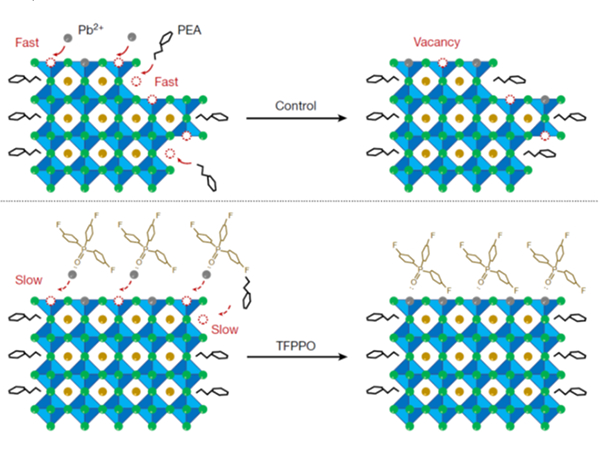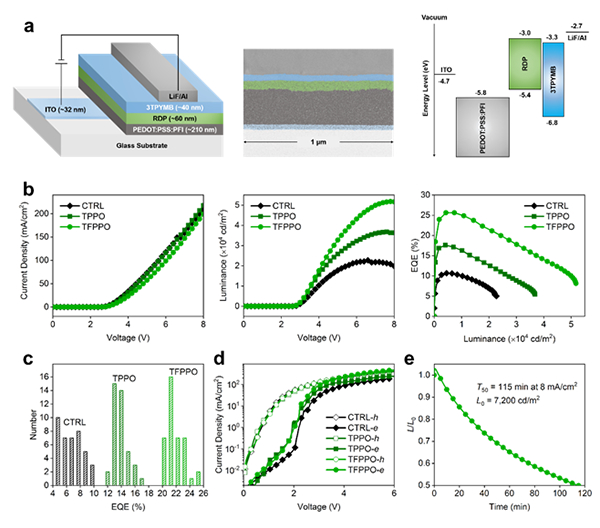With the support of National Natural Science Foundation of China (Grant: 51802102), the team of Prof. Zhanhua Wei, Institute of Luminescent Materials and Information Displays, College of Materials Science and Engineering, Huaqiao University, and his collaborators from University of Toronto made progress on perovskite light-emitting diodes. The research results were published in Nature on November 25, 2021, entitled “Distribution control enables efficient reduced-dimensional perovskite LEDs”. The article link is http://www.nature.com/articles/s41586-021-03997-z.
Light-emitting diodes (LEDs) based on perovskite quantum dots have shown external quantum efficiencies (EQEs) of over 23% and narrowband emission, but suffered from limited operating stability. Reduced-dimensional perovskites (RDPs) consisting of quantum wells (QWs) separated by organic intercalating cations show high exciton binding energies and have the potential to increase the stability and the photoluminescence quantum yield. However, until now, RDP-based LEDs have exhibited lower EQEs and inferior color purities.
We posit that the presence of variably confined QWs may contribute to non-radiative recombination losses and broadened emission. As shown in Figure 1, we report bright RDPs with a more monodispersed QW thickness distribution, achieved through the use of a bifunctional molecular additive that simultaneously controls the RDP polydispersity while passivating the perovskite QW surfaces. We synthesize a fluorinated triphenylphosphine oxide additive that hydrogen bonds with the organic cations, controlling their diffusion during RDP film deposition and suppressing the formation of low-thickness QWs. The phosphine oxide moiety passivates the perovskite grain boundaries via coordination bonding with unsaturated sites, which suppresses defect formation. This results in compact, smooth and uniform RDP thin films with narrowband emission and high photoluminescence quantum yield. As shown in Figure 2, this enables LEDs with an EQE of 25.6% with an average of 22.1 ±1.2% over 40 devices, and an operating half-life of two hours at an initial luminance of 7,200 candela per metre squared, indicating tenfold-enhanced operating stability relative to the best-known perovskite LEDs with an EQE exceeding 20%.

Figure 1 Distribution control strategy. During antisolvent-induced crystallization, [PbBr6]4- nuclei, MA and Cs+ cations assemble to form the perovskite flakes, allowing the PEA organic cations to diffuse and enter the extended perovskite lattice, thereby forming RDPs. In the control case, rapid diffusion of PEA leads to QW polydispersity, whereas in the case of crystallization with TFPPO added to the antisolvent, the fluorine atoms bind to PEA via hydrogen bonds, limiting their diffusion and promoting the formation of RDPs with monodispersed QWs. The P=O moiety additionally passivates the perovskite grain boundaries.

Figure 2 LED performance. a, Device structure (left), cross-sectional TEM image (middle) and energy band diagram (right). The energy levels of the RDPs were calculated from optical data and ultraviolet photoelectron spectroscopy (Extended Data Fig. 5). b, Current density versus voltage (left), luminance versus voltage (middle) and EQE versus luminance (right) curves. c, EQE histogram of 40 devices based on control, TPPO-treated and TFPPO-treated RDPs. d, Current density versus voltage curves of hole-only (h) and electron-only (e) devices based on control, TPPO-treated and TFPPO-treated RDPs. e, Operating stability of LEDs based on TFPPO-treated RDPs.

Add: 83 Shuangqing Rd., Haidian District, Beijing, China
Postcode: 100085
Tel: 86-10-62327001
Fax: 86-10-62327004
E-mail: bic@donnasnhdiary.org
京ICP备05002826号 文保网安备1101080035号 Copyright 2017 NSFC, All Right Reserved